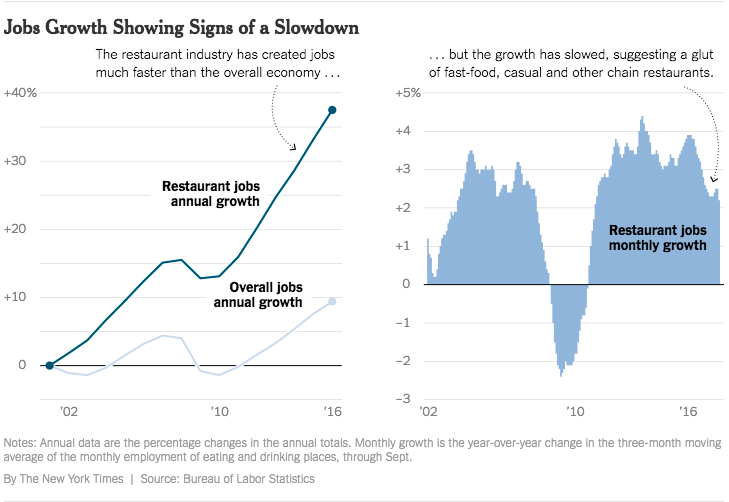Is Delivery Killing Fast Casual Too? (Long Busted Narratives)
Zoe's Kitchen is Latest Restaurant Showing Signs of Trouble
Fast casual is supposed to be a bright spot for restaurants. But as the segment has grown in recent years, there are bound to be winners and losers. Zoe’s Kitchen Inc., a fast casual Mediterranean food chain with 250 locations in 20 states ($ZOES), is increasingly looking like the latter.
Last week the company reported sh*tty earnings. Comp restaurant sales declined by 2.3% despite rising prices pushed on to the consumer. The decline is attributable to the usual array of externalities (e.g., weather) but also location cannibalization. Apparently, the company’s growth strategy is pulling consumers from previously established locations. Moreover, the company noted “inflationary pressures in produce and freight costs, that are expected to impact cost of goods sold for the balance of the year.” Wages also increased 3.3%, an acceleration from the 2.9% realized in Q4 ‘17. Accordingly, adjusted EBITDA decreased 30.9%. The net loss for the quarter was $3.6mm or -$0.19/share. The company lowered guidance. The stock tumbled.
Before you get too excited, note that this is a debt-light company: it currently has a ‘22 $50mm revolving credit facility with JPMorganChase Bank NA, of which $16.5mm is outstanding (with $3.7mm of cash on hand, net debt is only $12.8mm). It also, believe it or not, has covenants — leverage and interest coverage, among others — and the company is in compliance as of April 16, 2018. It also plans to continue its expansion: in the sixteen weeks ended 4/16/18, the company opened 11 company-owned restaurants with a plan to open approximately 25 (inclusive) over the course of fiscal year ‘18. That said, it does intend to rationalize existing locations (and expects some impairment charges as a result), cut G&A and take other operational performance improvement measures to combat its negative trends. There’s a potential opportunity here for low-to-middle-market FAs and real estate advisors.
For our part, we found this bit intriguing (unedited):
We are definitely seen more competitive intrusion, more square footage growth in some of those smaller kind of mid to kind of large markets where we've been there for some time now that's a little bit of what we're seeing in those markets.
We've also seen more competitive catering competition as every ones ramped up catering. And also the value and discounting as we spoke to in the call, in the prepared remarks we've seen that $10 check with that single user kind of moving around and we think that's so from the new competition square footage growth, the value and discounting and then the delivery interruption, we've seen or felt that in many of our markets.
There’s a lot to unpack there. Clearly competition, as we noted upfront, is increasing in the $10-check size cohort of fast casual. Catering is always a competitive business for restaurants like this too. But, the point that really got out attention was that about delivery. The company says pointedly, “We also believe that disruption from delivery and discounting has created headwinds.” The company further states,
Digital comps were 26% positive in Q1 as we leverage improvements from last year's investments in web and mobile platforms to build greater convenience for our guests. Early in Q2, we relaunched and upgraded our loyalty program, which is expected to help drive traffic by making it easier and clearer for our guest to earn and redeem rewards. Delivery sales grew in both our non-catering and catering businesses by 155%. And we have a clear plan to build out the channel for more profitable growth in 2018.
The impact of mobile food ordering and the need for delivery cannot be overstated. Companies need to act fast to activate delivery capabilities that makes sense to a mobile consumer who, more and more, goes to Postmates, Caviar, UberEats and other food delivery services for discovery. This is precisely why Shake Shack ($SHAK) is now on Postmates and Chipotle Mexican Grill Inc. ($CMG) is now available on Doordash. Others, like privately-owned Panera Bread are taking a step farther by building out its own delivery infrastructure in an attempt to own all its data and deliver without owing a cut to a middleman. Query whether this is far too much dependence on the likelihood of people to go directly to Panera’s app when they’re hungry…?
It sounds like the Zoe folks are increasing their focus on delivery. The question is whether they can execute fast enough to offset in-store dining declines. And whether they can do it on their own.



